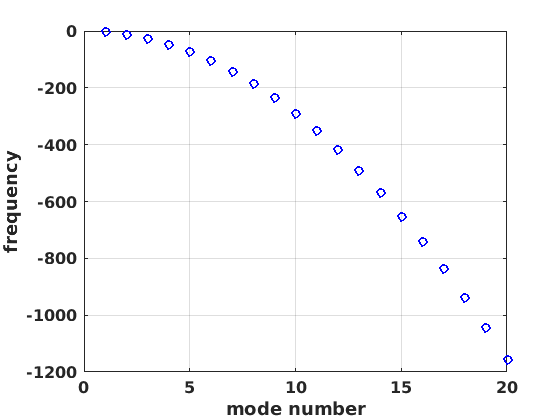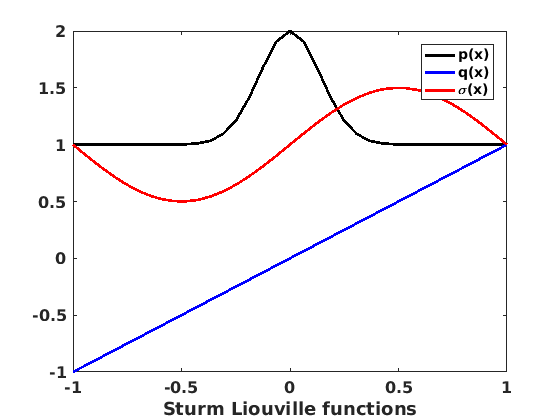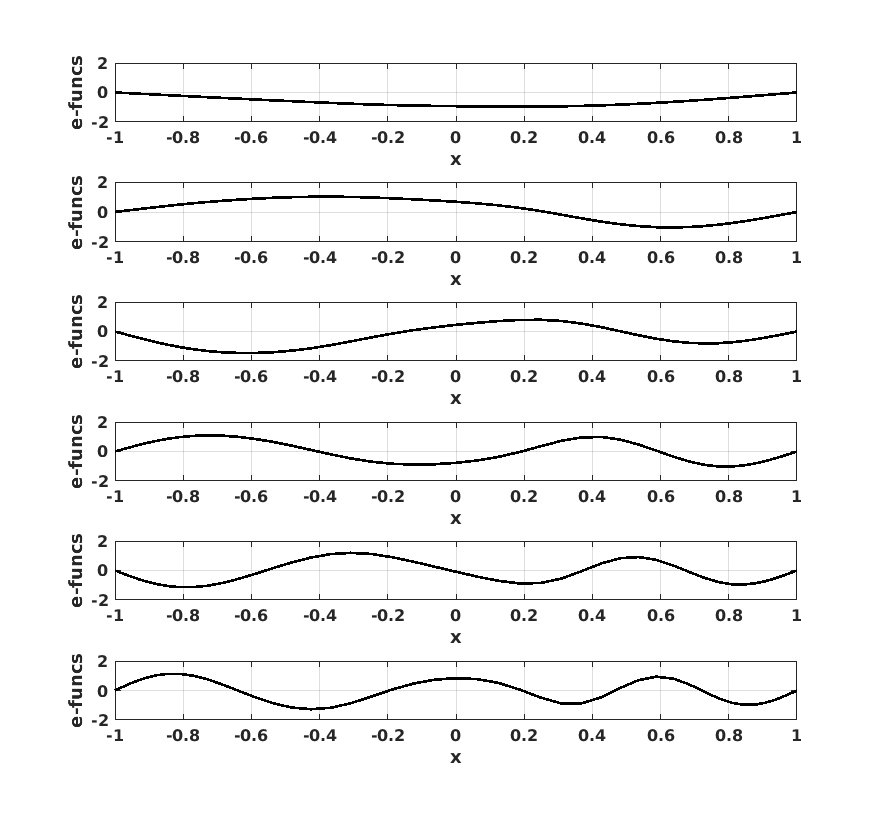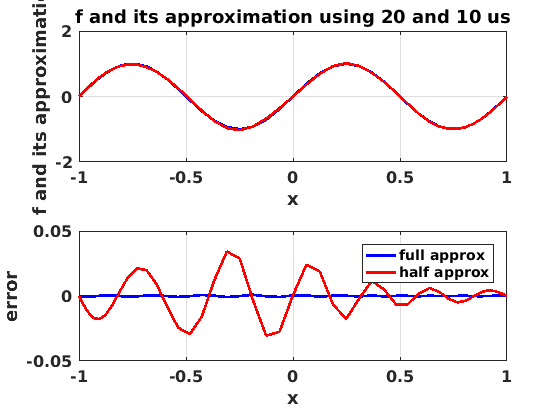Sturm-Liouville eigenvalue problem solver including projections
This script solves the classical Sturm-Liouville problem. This problem appears throughout applied mathematics and is similar to the traditional eigenvalue problem from linear algebra. However rather than a matrix we now have an operator and the variables are functions. We then project a function onto the basis formed by the eigenfunctions. The equations are:


The inner product is  .
.
Contents
clear all format long, format compact
Number of points and the derivative and integration material.
N=50; [D,x]=cheb(N); D2=D^2; % Differentiation matrices. [xi wt]=clencurt(N); % Integration coefficients.
Note the computational domain is [-1,1]
Define the various functions.
numdx=1e-8; myp=@(x) 1+exp(-(x/0.2).^2); mypx=@(x) (myp(x+numdx)-myp(x-numdx))/(2*numdx); myq=@(x) x; mysig=@(x) 1+0.5*sin(x*pi);
Build the operators.
myoplh=diag(myp(x))*D2+diag(mypx(x))*D+diag(myq(x)); myoprh=diag(mysig(x));
The boundary conditions are u=0 so just strip off the first and last row and column.
myoprh=myoprh(2:end-1,2:end-1); myoplh=myoplh(2:end-1,2:end-1);
Solve the eigenvalue problem and sort the eigenvalues.
[myphis0 mylams0]=eig(myoplh,myoprh);
[mylams mylamsi]=sort(diag(mylams0),'descend');
Set the number of modes you wish to consider.
num_modes=20; modesu=zeros(N+1,num_modes); modesu(2:N,:)=myphis0(:,mylamsi(1:num_modes)); modese=zeros(size(modesu));
Calculate Modes
for k=1:num_modes
unow=modesu(:,k);
Normalize using the inner product.
normalizationu(k)=sqrt(sum(wt'.*unow.^2.*mysig(x)));
modesu(:,k)=unow/normalizationu(k);
Notice the way the Clenshaw Curtis weights come in.
end
Figure 1
figure(1) clf set(gcf,'DefaultLineLineWidth',2,'DefaultTextFontSize',12,... 'DefaultTextFontWeight','bold','DefaultAxesFontSize',12,... 'DefaultAxesFontWeight','bold'); plot(mylams(1:20),'bo') xlabel('mode number') ylabel('frequency') grid on

Figure 2
figure(2) clf set(gcf,'DefaultLineLineWidth',2,'DefaultTextFontSize',12,... 'DefaultTextFontWeight','bold','DefaultAxesFontSize',12,... 'DefaultAxesFontWeight','bold'); plot(x,myp(x),'k-',x,myq(x),'b-',x,mysig(x),'r') xlabel('x') xlabel('Sturm Liouville functions') legend('p(x)','q(x)','\sigma(x)')

Figure 3
figure(3) clf set(gcf,'DefaultLineLineWidth',2,'DefaultTextFontSize',12,... 'DefaultTextFontWeight','bold','DefaultAxesFontSize',12,... 'DefaultAxesFontWeight','bold'); for modei=1:6 subplot(6,1,modei) plot(x,modesu(:,modei),'k-') xlabel('x') ylabel('e-funcs') grid on axis([-1 1 -2 2]) end

Projections
Now for some projections. First choose the function to project. Anything that satisfies the BCs is OK.
f=sin(2*pi*x); myapp=zeros(size(f)); for k=1:num_modes/2 phinow=modesu(:,k); coeff(k)=sum(wt'.*phinow.*f.*mysig(x)); myapp=myapp+coeff(k)*phinow; end myapphalf=myapp; for k=(num_modes/2+1):num_modes phinow=modesu(:,k); coeff(k)=sum(wt'.*phinow.*f.*mysig(x)); myapp=myapp+coeff(k)*phinow; end
Figure 4
figure(4) clf set(gcf,'DefaultLineLineWidth',2,'DefaultTextFontSize',12,... 'DefaultTextFontWeight','bold','DefaultAxesFontSize',12,... 'DefaultAxesFontWeight','bold'); subplot(2,1,1) plot(x,f,'k',x,myapp,'b',x,myapphalf,'r') xlabel('x') ylabel('f and its approximation') grid on title(['f and its approximation using ' int2str(num_modes) ' and ' int2str(num_modes/2) ' us']) subplot(2,1,2) plot(x,f-myapp,'b',x,f-myapphalf,'r') legend('full approx','half approx') grid on xlabel('x') ylabel('error')
